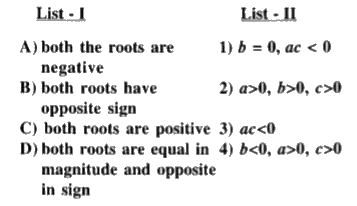Consider the Bohr's model of a one-electron atom where the electron moves around the nucleus. In the following, List-I contains some quantities for the nth orbit of the atom and List-II contains options showing how they depend on n.

Which of the following options has the correct combination considering List-I and List-II?
(IV), (U)
(IV), (Q)
(III), (P)
(III), (S)
The correct Answer is:B
Step by step video & image solution for Consider the Bohr's model of a one-electron atom where the electron moves around the nucleus. In the following, List-I contains some quantities for the n^("th") orbit of the atom and List-II contains options showing how they depend on n. Which of the following options has the correct combination considering List-I and List-II? by Chemistry experts to help you in doubts & scoring excellent marks in Class 12 exams.
Updated on:21/07/2023Topper's Solved these Questions
- ATOMIC STRUCTUREBOOK - VMC MODULES ENGLISHCHAPTER - ATOMIC STRUCTUREEXERCISE - JEE Main (Archive)
39 Videos
- AMINESBOOK - VMC MODULES ENGLISHCHAPTER - AMINESEXERCISE - IN CHAPTER EXERCISE H
10 Videos
- CHEMICAL BONDING & CHEMICAL STRUCTURE BOOK - VMC MODULES ENGLISHCHAPTER - CHEMICAL BONDING & CHEMICAL STRUCTURE EXERCISE - IMPECCABLE
50 Videos
Similar Questions
The quadratic equation ax2+bx+c=0 has two roots then match the following lists.

Find the correct match from List-I to List-II.
View SolutionIn Bohr model of the hydrogen atom, let R,v and E represent the radius of the orbit, speed of the electron and the total energy respectively. Which of the following quantities are directly proportional to the quantum number n?
View Solution
Knowledge Check
En=−(2,18×10−18)Z2n2
Electrons follow paths, called orbits around the nucleus of an atom. According to the Bohr model, the energy in joules of an atom's nth orbit containing a single electron is given by the formula shown above, where Z is the atomic number of the atom and n is the orbit number. Which of the following equations gives the atomic number of an atom given the energy of its nth orbit (assuming there is a single electron is that orbit)?AZ=109√−n2En2.18BZ=1109√−n2En2.18CZ=109√−2.18Enn2DZ=1109√−2.18Enn2In Bohr model of the hydrogen atom, let R,v and E represent the radius of the orbit, speed of the electron and the total energy respectively. Which of the following quantities are directly proportional to the quantum number n?
AVRBRECR/EDnone of theseSuppose an electron is attracted toward the origin by a forcekr where k is a constant and r is the distance of the electron from the origin .By applying Bohr model to this system the radius of the nth orbital of the electron is found to be rn and the kinetic energy of the electron to be Tn , Then which of the following is true ?
ATn∝1n2BTn is independent of n, rn∝nCTn∝1n and rnDTn∝1n and rn∝n2
Suppose an electron is attracted toward the origin by a forcekr where k is a constant and r is the distance of the electron from the origin .By applying Bohr model to this system the radius of the nth orbital of the electron is found to be rn and the kinetic energy of the electron to be Tn , Then which of the following is true ?
View SolutionA person in a lift is holding a water jar, which has a small hole at the lower end its side. When the lift is at rest, the water jet coming out of the hole hits the floor of the lift at a distance d of 1.2 m from the person. In the following, state of the lift’s motion is given in Column I and the distance where the water jet hits the floor of the lift is given in Column II. Match the statements from list I with those in list II and select the correct answer using the code given below the lists.

View SolutionMatch List I of the nuclear processes with List II containing parent nucleus and one of the end produces of each process and then select the correct answer using the codes gives below the list:
_E01_339_Q01.png)
View SolutionThe barrier potential of a p-n junction depends on : (i) type of semiconductor material (ii) amount of doping (iii) temperature.
Which is one of the following is correct?
View SolutionMolecular orbital (MOT) the atoms in a molecule are supposed to loose their individual control over the electrons . The nuclei of the bonded atoms are considered to be present at equilibrium in inter-nuclear positions . The orbitals where the probability of finding electrons is maximum are called molecular orbitals extending over 2 or more nuclei when a pair of atomic orbitals combine and give rise to a pair of molecular MO's in internuclear region but decreased for antibonding MO's . Shielding of the nuclei by-increased electron density in bonding MO's reduces inter nuclear repulsion & thus stabilizes the molecule whereas lower electron density in antibonding MO's increases the repulsion and destabilises the system .

Which of the following is the correct order of bond strength of given species ?
View Solution
